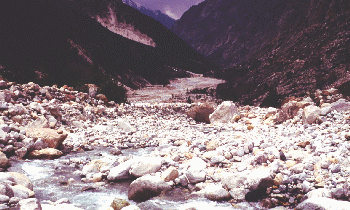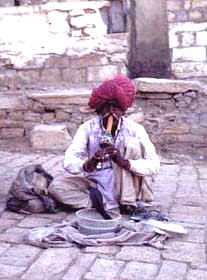Hinduism
Buddhism
Judaism
Christianity
Islam
© Wim van den Dungen

Salvation is the release
("moksa") of the eternal soul ("âtman") from the cycle of
birth-death-rebirth ("samsâra") to which each creature is subjected.
Hindu theology is polytheistic (millions of gods & goddesses), hyle-pluralistic
(multiple planes, strata or levels of being) & bi-polar (sleeping & waking
Brahman). Endless sacred actions take place between these Divine beings & humanity.
All are subject to the cycle of "samsâra", actioned by "karma".
In Brahmin circles (the high cast priests) "Brahman" is the untranslatable
Supreme God and refers to everything potential (unmanifested) & actual (manifested).
But foremost, Brahman is the impersonal absolute (cf."nirguna-Brahman" in
Vedânta). His "personal" polarity is called "saguna-Brahman",
"Îshvara", "Brahmâ" or "Paramâtma", a macrocosmic Soul.
Hindus call their tradition "sanâtana-dharma", the "eternal
religion".

The Hindu trinity of three supreme gods known as the "trimûrti" (Brahmâ,
Vishnu & Shiva) are the ontological blueprint of the creation, the sustenance &
the regeneration-through-destruction of "samsâra", the realm of illusion
("mâyâ). Part of this Divine illusion is evil. Only impersonal Brahman, the goal of
the yogins, is beyond good & evil. The universe is never without death,
destruction & suffering.
Numerous theologies exist. In the Advaita-Vedânta, "chit", or consciousness is
identical with Brahman. The distinction between subject & object is made within
consciousness. So consciousness is omnipresent. Real atheism is impossible. For one can
not claim God does not exist without a consciousness rooted in the Divine. Brahman is
also absolute, eternal, unchanging Being, or "Sat". The direct experience of
Brahman, implying a consciousness free from thoughts, projecting neither anxiety, care,
illness, old age, death & suffering, is pure bliss, or "ânanda". The triad
"Sat-Chit-ânanda" is fundamental.
THE ULTIMATE GOAL OF
SPIRITUALITY : UNION WITH
THE IMPERSONAL BRAHMAN |
Philosophical India has six traditional
angles of approach (or "darsana"). They are "traditional" or
"âstika" (orthodox) because they do not question the authority of the four Veda's
(unlike Buddhism & Jainism).
These ancient disciplines can be grouped :
(a) "vaisesika" (Kanânda) & "nyâna" (Gotama) form the
Nyâya-Vaisesika-system, dealing with ontology and logical analysis as method of knowledge
;
(b) Sâmkhya (Kapila) & Yoga (Patañjali) investigate the relationships between the
Self ("purusa") and the external world ("prakrti"). What is the nature
of the Self ? How can it be realized ?
(c) Mîmâmsâ (Jaimini) & Vedânta (Vyâsa, Sankara) study the criteria for the
validity of knowledge and see the conclusions of the Upanisads confirmed by the
rational investigation of knowledge and reality.
Today, Sâmkhya, Yoga & Vedânta remain actual.
"(...) the result of knowledge is a matter
of direct and immediate experience. For this reason also, knowledge cannot be a subsidiary
of rites (...) But should one build his hope of deriving the requisite competence for
rites from the knowledge of the âtman as taught in the Upanisads, he will be left only
with the destruction of all rites. From this also it follows that knowledge is independent
of rites."
Sankara : Brahma-Sûtra-Bhâsya, III.iv.15 &
16.
The law of duty established by the
scriptures of Hinduism ("dharma") & its ideas concerning action
("karma") define the religious ethics of Hinduism. In principle, evil (good)
deeds ripe evil (good) consequences. One attains the highest by not being attached to the
fruits of one's actions. This alone makes the soul ("jivâtman") escape from
"samsâra". Hence, it is the disposition of the individual (the intent
behind the
act) as well as the nature of the act which determine its morality or immorality
("adharma").
Sub-traditions : Brahmanism, followers of Vishnu, followers of Shiva ...
Criticism of Hinduism :
§ 1/+ In his The Natural History of Religion and Dialogues concerning Natural
Religion, David Hume suggests monotheism refers to the unity of nature, whereas
polytheism indicates its plurality. Polytheism implies that different Divine forces may
oppose each other (cf. the early Greek model of the world). Hence, different kinds of
religious actions & beliefs may cohabitate. The distance between humans & the
Divine is therefore less explicit than in monotheism. The teachings have an important,
ungoing oral component, reducing the possibility of dogma's and a restrictive canon (the
religions "of the Book" started orally but ended textually). These constructive
characteristics of polytheism promote the accessibility of the Divine. The other
side of this is the act of assuming Divine status.
§ 2/- Popular devotions and the theologies of the different schools differ. Although the
latter stress the unity of the Divine, and the Brahmins understand the various gods &
goddesses as expressions, aspects, modalities or forms of the One ("Brahman"),
most common believers tend to worship their god or goddess as a complete macrocosms on
its own. It seems as if the Divine is made after the image of those who worship,
which runs against the aim of spirituality. Not unlike
Ancient Egyptian theology, each god
or goddess is worshipped as the sole creator of the universe (of the many gods &
goddesses). Krishna, who found His way out of India, conveys to His devotees a vision of
His higher form, and He claims that "the gods are constantly craving for a vision of
this form" - cf. Bhagavad-Gîtâ, 11:51-52). The gods may incarnate in kings,
priests & military leaders and be venerated accordingly ...
§ 3/- Each individual school has to face certain internal problems. In classical yoga,
the status of the Self ("purusa") is problematic. A multitude of Selves are
postulated. So the final liberation of all types of consciousness is a pluralism of
Selves. They (each being alone) have nothing in common except their complete lack of
fluctuations. Because each Self is alone, it is difficult to understand the oneness of
ultimate realization ("dharma-megha-samâdhi"). In the Vedânta, the status of
objective existence is problematic. No other explanation of the universe can be formulated
than a total negation of its essence, reducing it to the sheer magic ("mâyâ")
of the Lord of the Universe. This pure idealism can not be taken serious when confronted
with the influence of material substance ("prakrti") on consciousness
("citta").
"Y a-t-il, oui ou non, une image multicolore, objectivée par la pure
incandescence - un monde manifesté par Brahma ? Les vedântistes ont répondu : 'L'image
-le monde- est un effet et, par conséquent, nous ne pouvons la définir ni comme réelle
ni comme irréelle." - Dandoy, G. : L'Ontologie du Vedânta, Desclée de Brouwer - Paris, 1932,
p.55.
Who
wrote the founding texts of Hinduism (the Vedas) and when this
happened remains unknown. It is said that these texts are handed down
"from mouth to mouth" from
a period of unknown antiquity. Many guesses exist as to the date of
their composition, but no date is incontestably true (Müller gives 1200
B.C.E., Haug 2400 BCE. and Tilak 4000 BCE.) Recent studies
(Feuerstein, Kak & Frawley, 1995), indicate 1900 BCE.
Dasgupta (A History of Indian
Philosophy, Motilal - Dehli, 1975, vol.1., p.10) as well as
Feuerstein (1995) claim they
were transmitted faithfully the last 3000 years with little or no
interpolations at all. If no historical sources are known (as is the case here),
nobody is able to check whether such a statement is true. How
to assess authenticity if
no criticism is possible ? Hence,
Hinduism is unable to give a solid and workable compositional history of
its founding texts.
Nevertheless, if we accept these texts are the work of a
large number of editors (vedic seers), a relative historical authenticity may be
attested. A final redaction (around 1900 BCE) of such lofty spiritual food
already represents quite a feat.

Classical Yoga






initiated : 6 IV 2000 - last update : 31
XII 2012
- version n°32
|


![]()